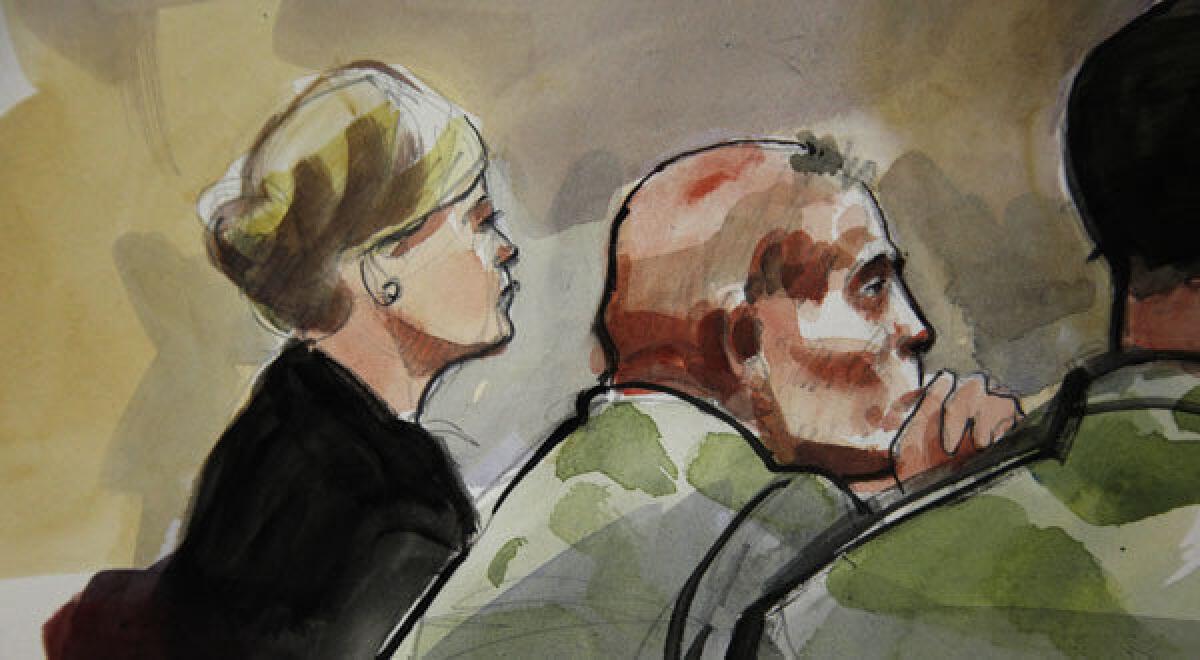Robert Bales case: Army investigators were delayed three weeks

- Share via
JOINT BASE LEWIS-McCHORD, Wash. — A U.S. Army criminal investigation team had to wait three weeks to visit the two Afghan villages where a 39-year-old infantryman is alleged to have killed 16 civilians because it was too dangerous to leave the base, the lead case agent testified Wednesday.
Villagers infuriated over the March 11 shootings had driven victims’ bodies to Camp Belambay and were milling angrily outside. The suspect, Staff Sgt. Robert Bales, was in custody there before being evacuated.
Investigators’ “initial goal was to travel to the crime scene, but that goal was not possible due to the outcry of the villagers,” said Matthew Hoffman, a reservist with the Army’s Criminal Investigative Division who normally works as a Phoenix police detective.
“The leadership there said the situation was too volatile.... Every time an American soldier would show himself, [the villagers] would become outraged,” he said. “They were fully expecting an ambush if we tried to go out there at the time.”
An Afghan security team made it to the villages on the day of the post-midnight killings but came under fire en route. One man was killed and two were injured.
The U.S. team finally got to the four housing compounds on April 2, accompanied by a massive security team: an Afghan Army platoon, U.S. mine sweepers, bomb-detection dogs, and two helicopters hovering constantly overhead.
The earlier Afghan team had gathered some shell casings and taken photographs, and Hoffman said his team gathered a few additional casings and samples of blood spatters.
There was also dramatic testimony Wednesday about the first word U.S. officials received of the shootings: Five injured civilians showed up at the gate of the unit’s battalion headquarters at Zangibad, not far from Camp Belambay.
“They came in all at once,” said Maj. Travis Hawks, a brigade surgeon who happened to be at the outpost.
Hawks said several of the victims appeared to be gravely wounded, one of them a girl under 10 named Zardana, with a head wound so severe that doctors at first put her aside as hopeless and moved on to others.
A teenage girl was bleeding from a wound near her breast. Neither she nor the male relative accompanying her would allow male doctors to examine her below the waist, and it wasn’t until much later that they learned she also had been shot in the groin and buttocks, Hawks said.
A man with a gunshot wound to the neck had lost a significant amount of blood.
Two male youths also had injuries, one of them — apparently Zardana’s brother, Rafiullah, interviewed recently by the Los Angeles Times— shot through the thigh.
Once the others were stabilized, Hawks said, he turned back to Zardana, who was still alive. Her brain could be seen through the top of her skull, brain matter was in her hair and she was vomiting.
Yet her heart was beating, if rapidly and irregularly.
“[We] decided it was incumbent on us, we had to do everything possible to try to help her,” Hawks said.
He started an intravenous line and moved to insert a breathing tube, although the only one they had in the rudimentary field hospital was too big for her small frame. A second doctor injected drugs to sedate and paralyze her, then they enclosed her in a special covering to keep her body temperature up.
“So she was alive when she left our station,” Hawks said.
Against daunting odds, Zardana survived.
ALSO:
One patient found dead in North Carolina hospital fire
Former Penn State president Spanier arraigned; out on bail
Second storm to hit Sandy-damaged Northeast; evacuations ordered
More to Read
Sign up for Essential California
The most important California stories and recommendations in your inbox every morning.
You may occasionally receive promotional content from the Los Angeles Times.








